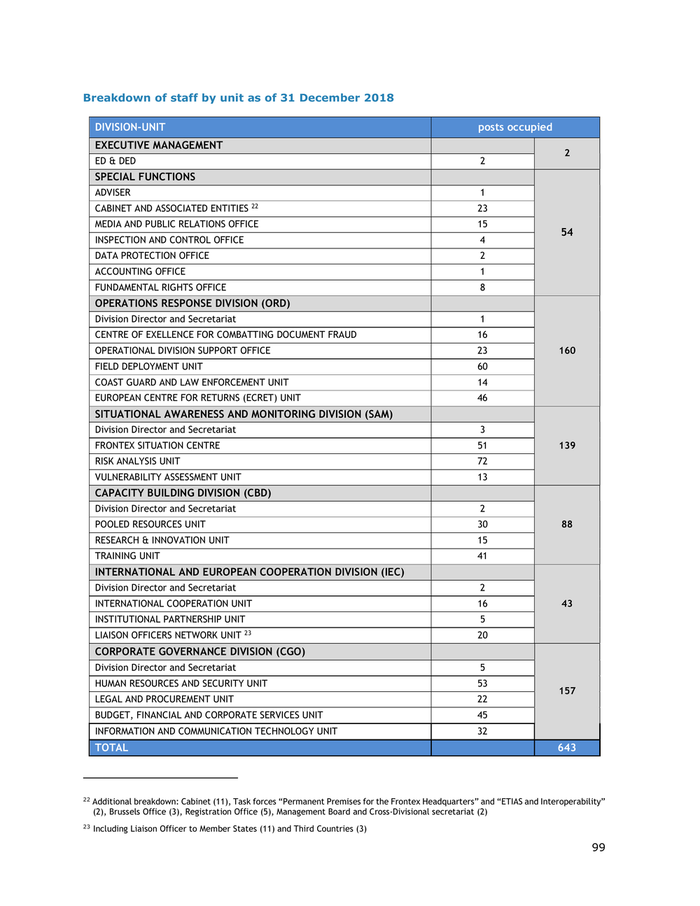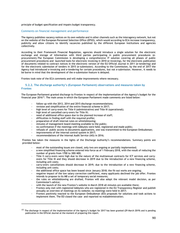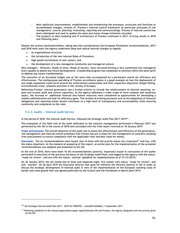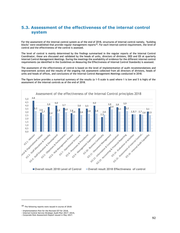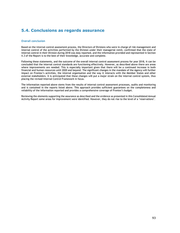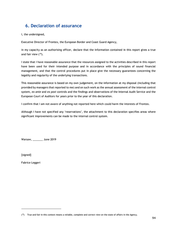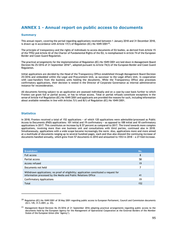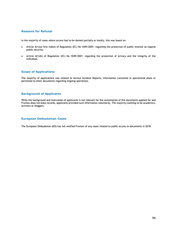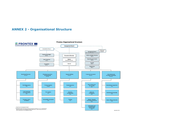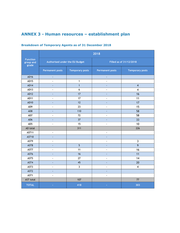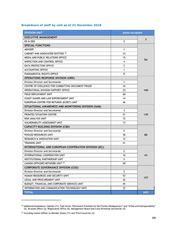Microsoft Word - CAAR_2018_FINAL_Adopted_Reg. No. 5865_13.06.19
principle of budget specification and impairs budget transparency. Comments on financial management and performance The Agency publishes vacancy notices on its own website and in other channels such as the interagency network, but not on the website of the European Personnel Selection Office (EPSO), which would according to ECA increase transparency, publicity and allow citizens to identify vacancies published by the different European Institutions and agencies collectively. According to their Framework Financial Regulation, agencies should introduce a single solution for the electronic exchange and storage of information with third parties participating in public procurement procedures (e- procurement).The European Commission is developing a comprehensive IT solution covering all phases of public procurement procedures and launched tools for electronic invoicing in 2010 (e-invoicing), for the electronic publication of documents related to contract notices in the electronic version of the EU Official Journal in 2011 (e-tendering) and for the electronic submission of tenders in 2015 (e-submission). According to the Commission, by the end of 2017 the Agency had introduced e-invoicing and e-tendering for certain procedures, but not e-submission. However, it needs to be borne in mind that the development of the e-submission feature is delayed. Frontex took note of the ECA comments and will make improvements where necessary. 5.2.2. The discharge authority’s (European Parliament) observations and measures taken by Frontex The European Parliament granted discharge to Frontex in respect of the implementation of the Agency’s budget for the financial year 201615. The main areas in which the European Parliament made comments are listed below: - follow up with the 2013, 2014 and 2015 discharge recommendations; - revision and simplification of the entire financial scheme in 2017; - high level of carry-overs for Title II (administrative) and Title III (operational); - high level of cancelled carry-overs for Title III; - need of additional office space due to the planned increase of staff; - difficulties in finding staff with the required profile; - preparation of draft internal rules on whistleblowing; - minutes of management board meeting available to the public; - no confirmation if the meetings with lobbyists were held, registered and made public; - refusals of public access to documents applications, one was transmitted to the European Ombudsman; - improvements of the internal control system in 2017; - recommendations of the Internal Audit Service (IAS) in 2016; Frontex has taken the measures in the lights of the Discharge Authority’s recommendations. Summary points are provided below: - most of the outstanding issues are closed, only two are ongoing or partially implemented; - a new simplified financing scheme entered into force as of 1 February 2018, with the result of reducing the number of grants from 1700 to 300/400; - Title II carry-overs were high due to the nature of the multiannual contracts for ICT services and carry- overs for Title III and they should decrease in 2019 due to the introduction of a new financing scheme, including unit costs; - carry-overs cancellations should decrease in 2019, due to the introduction of a new financing scheme, including unit costs; - the additional office space has been leased since January 2018; the fit-out works are ongoing; - negative impact of the low salary correction coefficient, many applicants declined the job offer. Frontex intends to propose to its MB a set of temporary social measures; - the rules on whistleblowing are drafted, Frontex will also adopt the relevant model decision, as per Commission’s advice; - with the launch of the new Frontex’s website in March 2018 all minutes are available there; - Frontex only met with registered lobbyists who are registered in the EU Transparency Register and publish annually an overview of meetings on its website; no meetings were held in 2017; - Frontex positively reacted to the European Ombudsman (EO) proposals for solutions and took actions to implement them. The EO closed the case and reported no maladministration; 15 The discharge in respect of the implementation of the Agency’s budget for 2017 has been granted (29 March 2019) and is pending publication in the Official Journal at the moment of preparing this report. 90
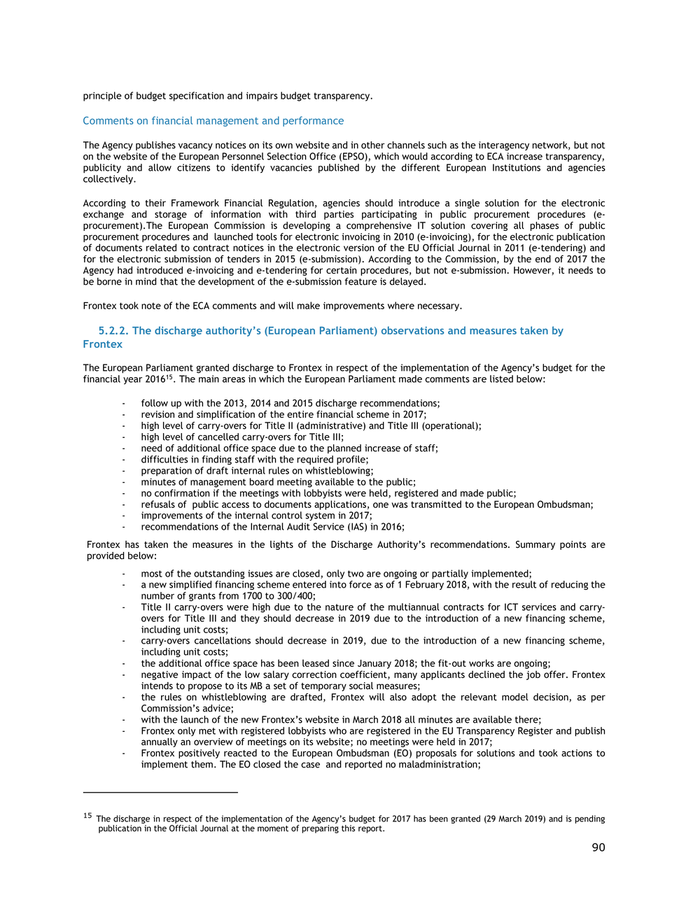
- Most significant improvements: establishment and streamlining the processes, structures and functions to accommodate changes, revision of Frontex’s internal control framework (in particular processes of risk management, control, planning, evaluating, reporting and communicating). Process of internal control has been redesigned and used to update the plans and assess change initiatives recorded; - The projects on data modeling and IT architecture of Frontex continued in 2017, to bring results in 2018 and following years. Despite the actions mentioned before, taking also into considerations the European Parliament recommendations, 2017 and 2018 were years the Agency underwent deep and radical internal changes as regards its organisational structure, the introduction of the new internal Rules of Procedure, high speed recruitments of new comers, and the development of a new managerial community and managerial culture. New managers - Directors, Heads of Units, Heads of Sectors- were recruited forming a very committed new managerial level capable to absorb any future developments. A leadership program was completed to continue within the same spirit to address any future transformation. The execution of an increased budget was at the same time accompanied by a permanent search for efficiency and effectiveness. The multipurpose patrolling of Frontex surveillance assets is a good example on how the deployment of one single equipment could serve several law enforcement communities and their respective objectives (illegal fishing, environmental crime, unlawful activities in the vicinity of Europe). Reforming Frontex’ internal governance was a further priority to include the reinforcement of internal reporting, ex- ante and ex-post audit and control capacities. As the agency addresses a wider scope of more complex and numerous topics, the increase of additional financial and human resources were considered as opportunities for developing a modern administration and look for efficiency gains. The revision of existing processes such as the adaptation of financial delegations and reporting duties should contribute to a high level of transparency and accountability while ensuring conformity and compliance to the rules. 5.2.3. Audits — Internal Audit Service In the period of 2018, the Internal Audit Service, followed the Strategic Audit Plan 2017−2019 16. The evaluation of the field visit of the audit dedicated to the contract management performed in February 2017 was performed by the IAS in the course of 2018 and concluded with the final report received on 18 January 2019. Scope and purpose: The overall objective of the audit was to assess the effectiveness and efficiency of the governance, risk management and internal control processes that Frontex has put in place for the management of contracts resulting from procurement to ensure compliance with the applicable rules and best value for money. Outcomes: The six recommendations were issued, four of them with the priority status very important17 and two, with the status important. At the moment of preparing of this report, an action plan for the implementation of the accepted recommendations was adopted and presented to the IAS. At the end of 2018, there have been 16 IAS recommendations (priority: important) issued in conclusions of the audits performed in execution of the previous iterations of the Strategic Audit Plans, and logged by the Agency with the status: ‘ready for review’, and one with the status: ‘started’ (deadline for implementation as of 31/12/2019). On 26 January 2019, the IAS closed one of them and reopened eight; five remain with status: ‘ready for review’, and one: ‘started’. On 26 April 2019 the Executive director met upon his initiative the Director General of IAS in order to discuss the strategic development of internal audit in view of the implementation of the European standing corps of border and coast guards that was agreed politically by the Council and the Parliament in March/April 2019. 16 IAS Strategic Internal Audit Plan 2017 − 2019 for FRONTEX − Ares(2017)4326621, 5 September 2017 17 Following conditions of the mutual expectations paper signed between IAS and Frontex, the Agency disagreed with the priority given by the IAS. 91
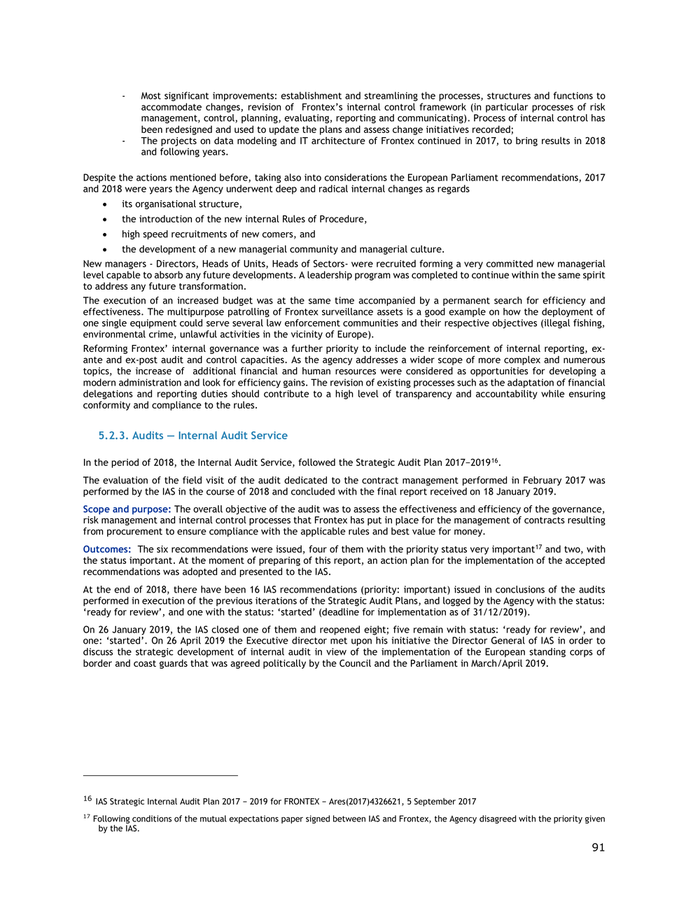
5.3. Assessment of the effectiveness of the internal control system For the assessment of the internal control system as of the end of 2018, structures of internal control namely, ‘building blocks’ were established that provide regular management reports18. For each internal control requirement, the level of control and the effectiveness of the control is assessed. The level of control is mainly determined by the findings summarised in the regular reports of the Internal Control Coordinator; these are discussed and validated by the heads of units, directors of divisions, DED and ED at quarterly Internal Control Management Meetings. During the meetings the availability of evidence for the different internal control requirements (as identified in the Guidelines on Measuring the Effectiveness of Internal Control Standards) is assessed. The assessment of the effectiveness of control is based on the level of implementation of audit recommendations and improvement actions and the results of the ongoing risk assessment collected from all directors of divisions, heads of units and heads of offices, and conclusions of the Internal Control Management Meetings conducted in 2018. The figure below provides a numerical summary of the results (a 1−5 scale is used where 1 is low and 5 is high) of the assessment of the internal controls as of the end of 2018. Assessment of the effectiveness of the Internal Control principles 2018 5,0 4,8 4,5 4,0 4,0 3,9 3,8 3,7 3,8 3,8 4,0 3,6 3,5 3,4 3,5 3,2 3,0 2,8 3,1 3,2 3,1 2,9 2,9 2,8 2,8 3,0 2,7 2,6 2,6 2,6 2,72,7 2,7 2,6 2,5 2,4 2,3 2,5 2,0 1,5 1,0 0,5 0,0 Overall result 2018 Level of Control Overall result 2018 Effectiveness of control 18 The following reports were issued in course of 2018: - Implementation Plan for the Revised ICF for 2018, - Internal Control Service Strategic Audit Plan 2017−2019, - Corporate Risk Assessment Report issued in May 2017. 92
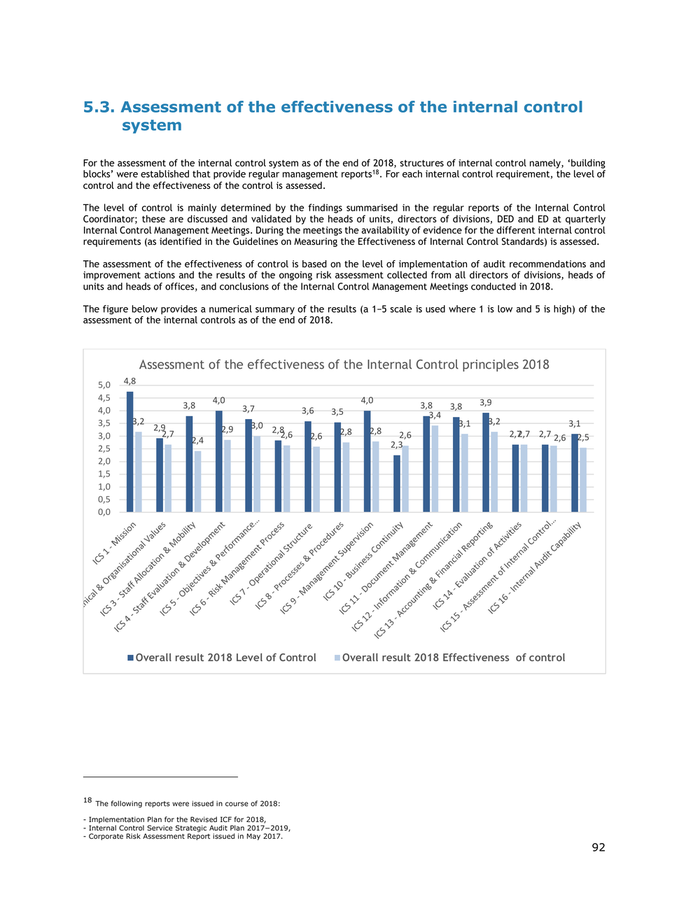
5.4. Conclusions as regards assurance Overall conclusion Based on the internal control assessment process, the Directors of Divisions who were in charge of risk management and internal control of the activities performed by the Division under their managerial remit, confirmed that the state of internal control in their Division during 2018 was duly reported, and the information provided and represented in Section II.3 of the Report is to the best of their knowledge, accurate and complete. Following these statements, and the outcome of the overall internal control assessment process for year 2018, it can be concluded that the internal control standards are functioning effectively. However, as described above there are areas where improvements are needed. This is especially important given that there will be a continued increase in both financial and human resources until 2020 and beyond. The significant changes in the mandate of the Agency will further impact on Frontex’s activities, the internal organisation and the way it interacts with the Member States and other external stakeholders. It is anticipated that these changes will put a major strain on the internal control system, thus placing the revised Internal Control Framework in focus. The information reported above stems from the results of internal control assessment processes, audits and monitoring and is contained in the reports listed above. This approach provides sufficient guarantees on the completeness and reliability of the information reported and provides a comprehensive coverage of Frontex’s budget. Reviewing the elements supporting the assurance as described and the evidence as presented in this Consolidated Annual Activity Report some areas for improvement were identified. However, they do not rise to the level of a ‘reservations’. 93

6. Declaration of assurance I, the undersigned, Executive Director of Frontex, the European Border and Coast Guard Agency, in my capacity as an authorising officer, declare that the information contained in this report gives a true and fair view (19). I state that I have reasonable assurance that the resources assigned to the activities described in this report have been used for their intended purpose and in accordance with the principles of sound financial management, and that the control procedures put in place give the necessary guarantees concerning the legality and regularity of the underlying transactions. This reasonable assurance is based on my own judgement, on the information at my disposal (including that provided by managers that reported to me) and on such work as the annual assessment of the internal control system, ex ante and ex post controls and the findings and observations of the Internal Audit Service and the European Court of Auditors for years prior to the year of this declaration. I confirm that I am not aware of anything not reported here which could harm the interests of Frontex. Although I have not specified any ‘reservations’, the attachment to this declaration specifies areas where significant improvements can be made to the internal control system. Warsaw, _______ June 2019 [signed] Fabrice Leggeri (19) True and fair in this context means a reliable, complete and correct view on the state of affairs in the Agency. 94
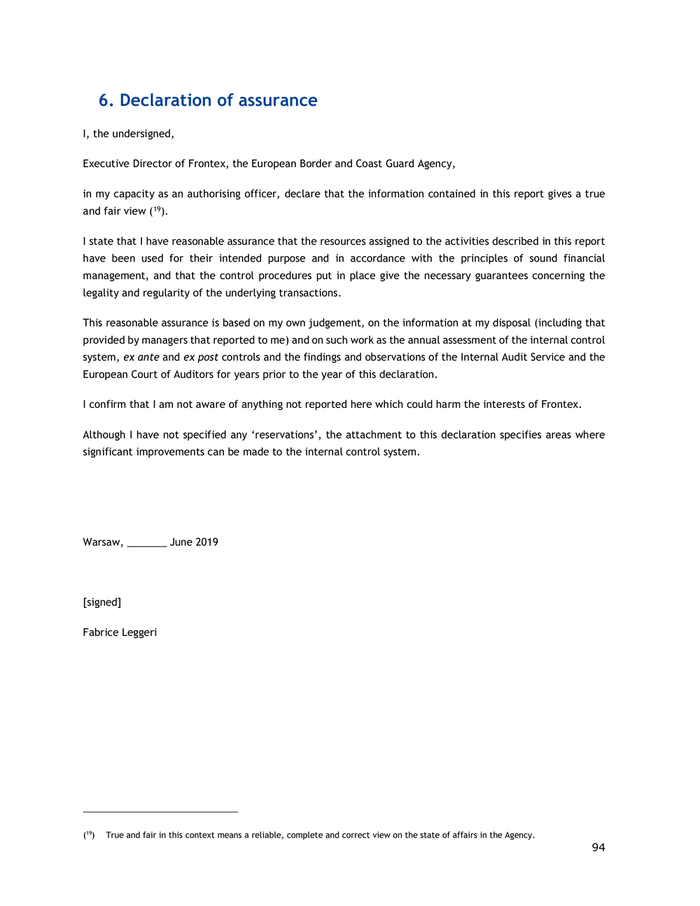
ANNEX 1 - Annual report on public access to documents Summary This annual report, covering the period regarding applications received between 1 January 2018 and 31 December 2018, is drawn up in accordance with Article 17(1) of Regulation (EC) No 1049/2001 20. The principle of transparency and the rights of individuals to access documents of EU bodies, as derived from Article 15 of the TFEU and Article 42 of the Charter of Fundamental Rights of the EU, is reemphasised in Article 74 of the European Border and Coast Guard Regulation. The practical arrangements for the implementation of Regulation (EC) No 1049/2001 are laid down in Management Board Decision No 25/2016 of 21 September 201621, adopted pursuant to Article 74(3) of the European Border and Coast Guard Regulation. Initial applications are decided by the Head of the Transparency Office established through Management Board Decision 25/2016 and embedded within the Legal and Procurement Unit, as successor to the Legal Affairs Unit, in cooperation with case-handlers from the business units holding the documents. While the Transparency Office also processes confirmatory applications, their decision is vested in the Director of Corporate Governance as internal administrative instance for reconsideration. All documents forming subject to an application are assessed individually and on a case-by-case basis further to which Frontex can grant full or partial access, or has to refuse access. Total or partial refusals constitute exceptions in the sense of Article 4 of Regulation (EC) No 1049/2001 and applicants are provided the reasons for such, including information about available remedies in line with Articles 7(1) and 8(1) of Regulation (EC) No 1049/2001. Statistics In 2018, Frontex received a total of 152 applications − of which 120 applications were admissible/processed as Public Access to Documents (PAD) applications: 101 initial and 19 confirmatory − as opposed to 108 initial and 10 confirmatory applications in 2017. This constitutes an increase by 8.57 percent as compared to 2017. The trend towards more complex applications, involving more than one business unit and consultations with third parties, continued also in 2018. Simultaneously, applications with a wide scope became increasingly the norm. Also, applications more and more aimed at a multitude of documents ranging up to several hundred pages, each and thus also showed the continuing increase of documents handled annually, which grew from 57 documents in 2010 and amounted to 1553 in 2018 − a 27-fold increase. Breakdown No. Full access 8 Partial access 58 Access refused 19 Documents not held 7 Withdrawn applications; no proof of eligibility; application constituted a request for information processed by the Media and Public Relations Office 41 Confirmatory Applications 19 Total 152 20 Regulation (EC) No 1049/2001 of 30 May 2001 regarding public access to European Parliament, Council and Commission documents (OJ L 145, 31.5.2001, p. 43). 21 Management Board Decision No 25/2016 of 21 September 2016 adopting practical arrangements regarding public access to the documents held by the European Agency for the Management of Operational Cooperation at the External Borders of the Member States of the European Union (the ‘Agency’). 95
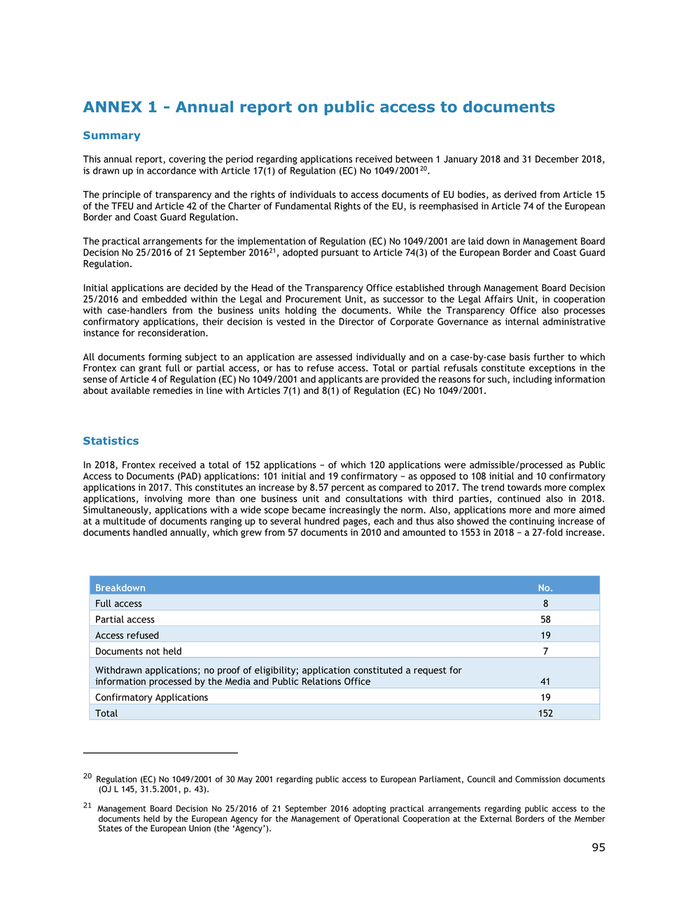
Reasons for Refusal In the majority of cases where access had to be denied partially or totally, this was based on: Article 4(1)(a) first indent of Regulation (EC) No 1049/2001: regarding the protection of public interest as regards public security; Article 4(1)(b) of Regulation (EC) No 1049/2001: regarding the protection of privacy and the integrity of the individual. Scope of Applications The majority of applications was related to Serious Incident Reports, information contained in operational plans or pertained to other documents regarding ongoing operations. Background of Applicants While the background and motivation of applicants is not relevant for the examination of the documents applied for and Frontex does not keep records, applicants provided such information voluntarily. The majority claiming to be academics, activists or bloggers. European Ombudsman Cases The European Ombudsman (EO) has not notified Frontex of any cases related to public access to documents in 2018. 96
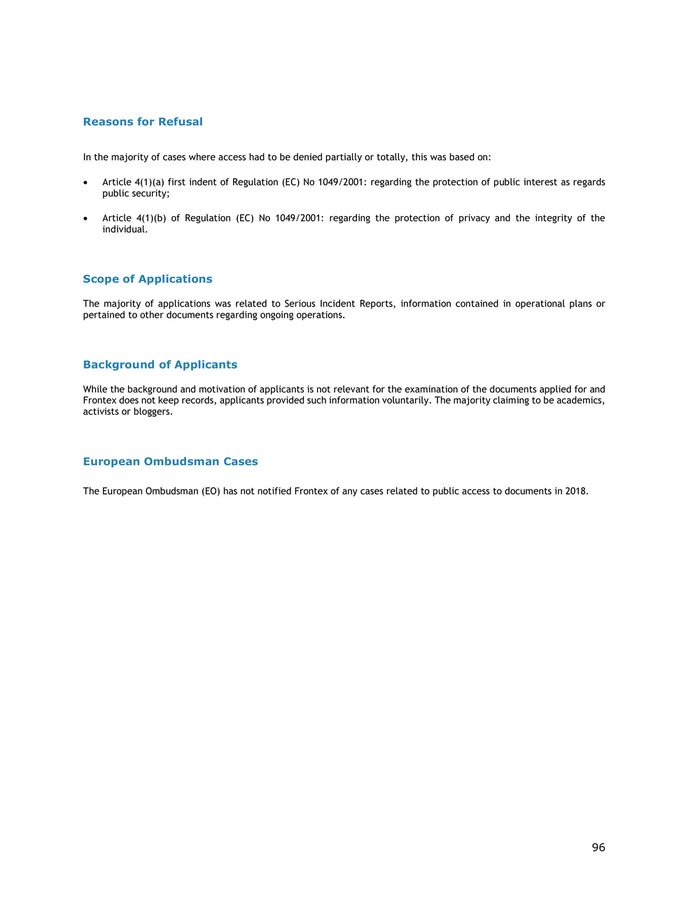
ANNEX 2 - Organisational Structure
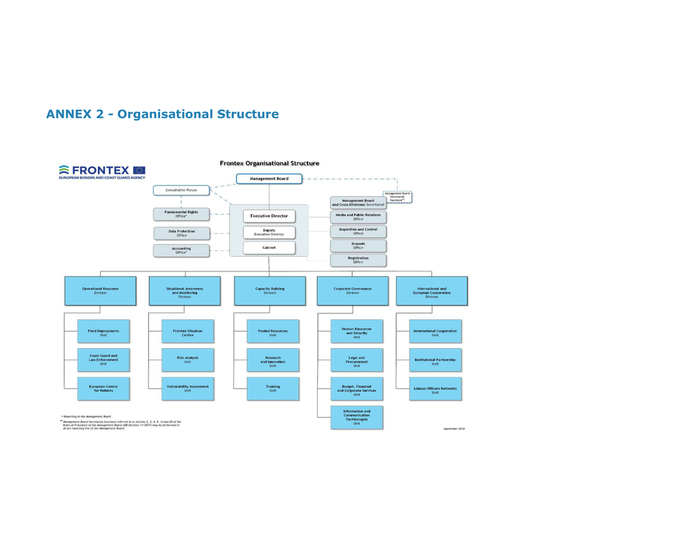
ANNEX 3 - Human resources – establishment plan Breakdown of Temporary Agents as of 31 December 2018 2018 Function group and Authorised under the EU Budget Filled as of 31/12/2018 grade Permanent posts Temporary posts Permanent posts Temporary posts AD16 - - AD15 - 1 - AD14 - 1 - 4 AD13 - 6 - 4 AD12 - 17 - 16 AD11 - 17 - 11 AD10 - 12 - 17 AD9 - 23 - 15 AD8 - 110 - 58 AD7 - 72 - 58 AD6 - 37 - 33 AD5 - 15 - 10 AD total 311 226 AST11 - - AST10 - - AST9 - - 3 AST8 - 5 - 9 AST7 - 11 - 16 AST6 - 16 - 11 AST5 - 27 - 14 AST4 - 45 - 20 AST3 - 3 - 4 AST2 - - AST1 - - AST total 107 77 TOTAL - 418 - 303
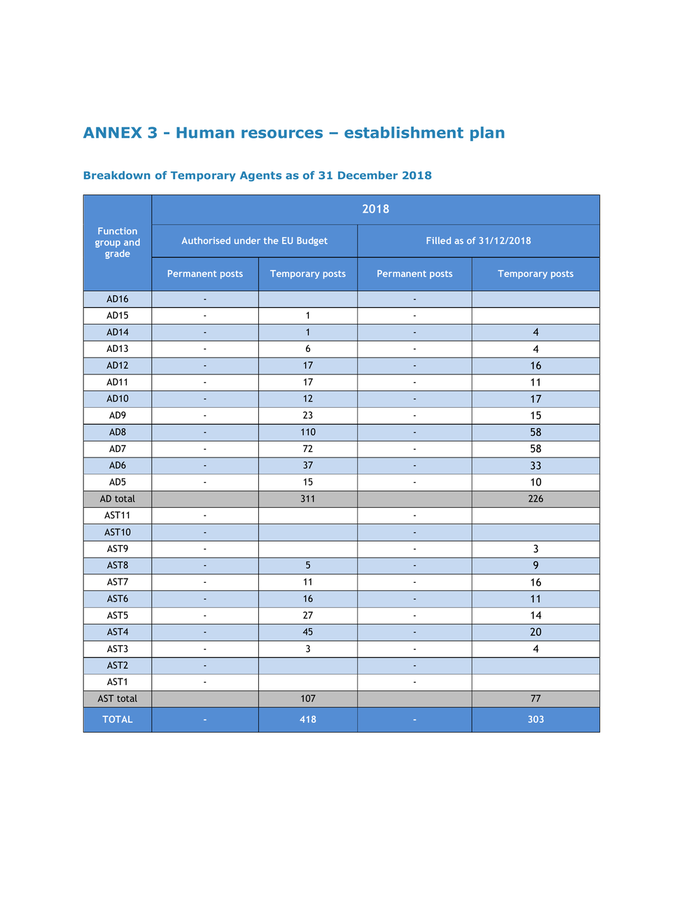
Breakdown of staff by unit as of 31 December 2018 DIVISION-UNIT posts occupied EXECUTIVE MANAGEMENT 2 ED & DED 2 SPECIAL FUNCTIONS ADVISER 1 22 CABINET AND ASSOCIATED ENTITIES 23 MEDIA AND PUBLIC RELATIONS OFFICE 15 54 INSPECTION AND CONTROL OFFICE 4 DATA PROTECTION OFFICE 2 ACCOUNTING OFFICE 1 FUNDAMENTAL RIGHTS OFFICE 8 OPERATIONS RESPONSE DIVISION (ORD) Division Director and Secretariat 1 CENTRE OF EXELLENCE FOR COMBATTING DOCUMENT FRAUD 16 OPERATIONAL DIVISION SUPPORT OFFICE 23 160 FIELD DEPLOYMENT UNIT 60 COAST GUARD AND LAW ENFORCEMENT UNIT 14 EUROPEAN CENTRE FOR RETURNS (ECRET) UNIT 46 SITUATIONAL AWARENESS AND MONITORING DIVISION (SAM) Division Director and Secretariat 3 FRONTEX SITUATION CENTRE 51 139 RISK ANALYSIS UNIT 72 VULNERABILITY ASSESSMENT UNIT 13 CAPACITY BUILDING DIVISION (CBD) Division Director and Secretariat 2 POOLED RESOURCES UNIT 30 88 RESEARCH & INNOVATION UNIT 15 TRAINING UNIT 41 INTERNATIONAL AND EUROPEAN COOPERATION DIVISION (IEC) Division Director and Secretariat 2 INTERNATIONAL COOPERATION UNIT 16 43 INSTITUTIONAL PARTNERSHIP UNIT 5 LIAISON OFFICERS NETWORK UNIT 23 20 CORPORATE GOVERNANCE DIVISION (CGO) Division Director and Secretariat 5 HUMAN RESOURCES AND SECURITY UNIT 53 157 LEGAL AND PROCUREMENT UNIT 22 BUDGET, FINANCIAL AND CORPORATE SERVICES UNIT 45 INFORMATION AND COMMUNICATION TECHNOLOGY UNIT 32 TOTAL 643 22 Additional breakdown: Cabinet (11), Task forces “Permanent Premises for the Frontex Headquarters” and “ETIAS and Interoperability” (2), Brussels Office (3), Registration Office (5), Management Board and Cross-Divisional secretariat (2) 23 Including Liaison Officer to Member States (11) and Third Countries (3) 99
